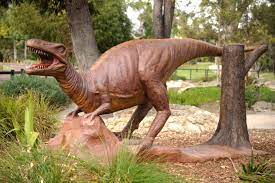
The ancient landscapes of Australia hold secrets that time has buried deep within the Earth. Among these mysteries emerges Ozraptor, an enigmatic dinosaur whose story is etched in fragments of bone and stone. As a resident of the Mesozoic Era, Ozraptor prowled the ancient terrain, leaving behind tantalizing clues to its existence. While much of its life remains veiled in uncertainty, the fragments of knowledge we possess unveil a captivating narrative of an Australian theropod.
Discovered in the rugged landscapes of Australia, Ozraptor's fossils paint a picture of a creature that once roamed a land vastly different from today. Its identity as a theropod, a group known for its carnivorous nature and sharp predatory instincts, places Ozraptor within the intricate web of prehistoric life.
| Name: | Ozraptor dinosaurs |
| Size: | About 9 feet long and 100 pounds. |
| Main Facts: | Ozraptor is an enigmatic Australian theropod with limited known details, fueling scientific curiosity and inquiry. |
Ozraptor's incomplete story invites speculation and fuels scientific inquiry. Its bones offer a canvas upon which paleontologists envision the shape, movement, and behavior of a long-lost world. Each discovery, each analysis, adds a stroke to this portrait of the past, illuminating the unique features and adaptations that allowed Ozraptor to thrive in a dynamic ecosystem.

The dimensions of Ozraptor are uncertain, but it is thought to have been a relatively small theropod. Its size may have ranged from a few to several meters in length. Its proportions would have been adapted for agility and potentially capturing prey.
Ozraptor's behavior is a subject of speculation, guided by its theropod lineage and its presumed carnivorous diet. Like other theropods, it likely walked on two legs and used its sharp teeth and claws for hunting. Given its potential small size, Ozraptor might have targeted smaller animals such as insects, small mammals, or even fish in nearby water sources.
As an apex predator in its local ecosystem, /Ozraptor would have played a crucial role in regulating prey populations. Its presence would have influenced the dynamics of its habitat, shaping the interactions among various species and contributing to the overall balance of the ecosystem.
Ozraptor's fossil discovery in Australia hints at its likely habitat and geographic range. During the Mesozoic Era, Australia was characterized by diverse landscapes, including forests, plains, and coastlines. Ozraptor's adaptations may have allowed it to thrive in these varied environments.
Ozraptor, an Australian theropod, remains a mysterious figure in paleontology due to limited fossil evidence. Its identity, appearance, and behavior are subjects of ongoing research, offering a tantalizing glimpse into Australia's prehistoric past. Discovered through fragmentary remains, Ozraptor's classification within the theropod group implies a carnivorous lifestyle, possibly occupying diverse ecological niches.
Its existence underscores the unique Mesozoic ecosystems of Australia, shedding light on the continent's isolated evolutionary history as part of Gondwana. While Ozraptor's story is incomplete, its enigmatic presence ignites curiosity and drives scientific inquiry, reminding us of the vast depths of prehistoric knowledge waiting to be unearthed.
Ozraptor's classification as a theropod places it within a diverse group of bipedal carnivorous dinosaurs. Comparisons with well-known theropods like Velociraptor and Dilophosaurus reveal potential similarities and differences in anatomy, behavior, and ecological roles. While Ozraptor may share certain features with these relatives, its specific adaptations remain enigmatic.
Ozraptor's presumed small size places it among other diminutive theropods like Compsognathus and Microraptor. These small predators likely occupied similar ecological niches, hunting smaller prey and potentially using speed and agility to their advantage. Comparing Ozraptor to these counterparts may shed light on its locomotion, hunting strategies, and potential interactions within its ecosystem.
Comparing Ozraptor with other Australian dinosaurs provides insights into the unique fauna of this region. While many well-known dinosaurs hail from other continents, Ozraptor represents a piece of the puzzle that completes the picture of Australia's prehistoric biodiversity. Understanding its relationships to other Australian dinosaurs can illuminate the broader evolutionary history of the continent.
Ozraptor's carnivorous nature invites comparisons with other theropods that shared similar dietary habits. Its teeth, claws, and overall body structure may have been adapted for hunting and consuming prey. Comparing these adaptations with those of other theropods can provide clues about Ozraptor's preferred prey types and hunting strategies.
Ozraptor's limited fossil evidence and unique adaptations make it a puzzle in the larger context of theropod evolution. Comparing its features with those of other theropods may help researchers identify convergent or specialized traits that allowed Ozraptor to thrive in its specific habitat or ecological niche.
Studying Ozraptor alongside other dinosaurs allows scientists to identify broader evolutionary trends within the theropod group. Comparisons can reveal changes in body size, locomotion, feeding habits, and other adaptations over time. These insights contribute to a more comprehensive understanding of how dinosaurs diversified and adapted to various environments.
Comparing Ozraptor's features and adaptations with those of dinosaurs from other regions offers a glimpse into the influence of paleogeography on evolutionary pathways. Different continents presented unique challenges and opportunities for dinosaur survival, leading to variations in adaptations and behaviors.